engine Abarth 500 2016 Owner handbook (in English)
[x] Cancel search | Manufacturer: ABARTH, Model Year: 2016, Model line: 500, Model: Abarth 500 2016Pages: 215, PDF Size: 19.08 MB
Page 97 of 215
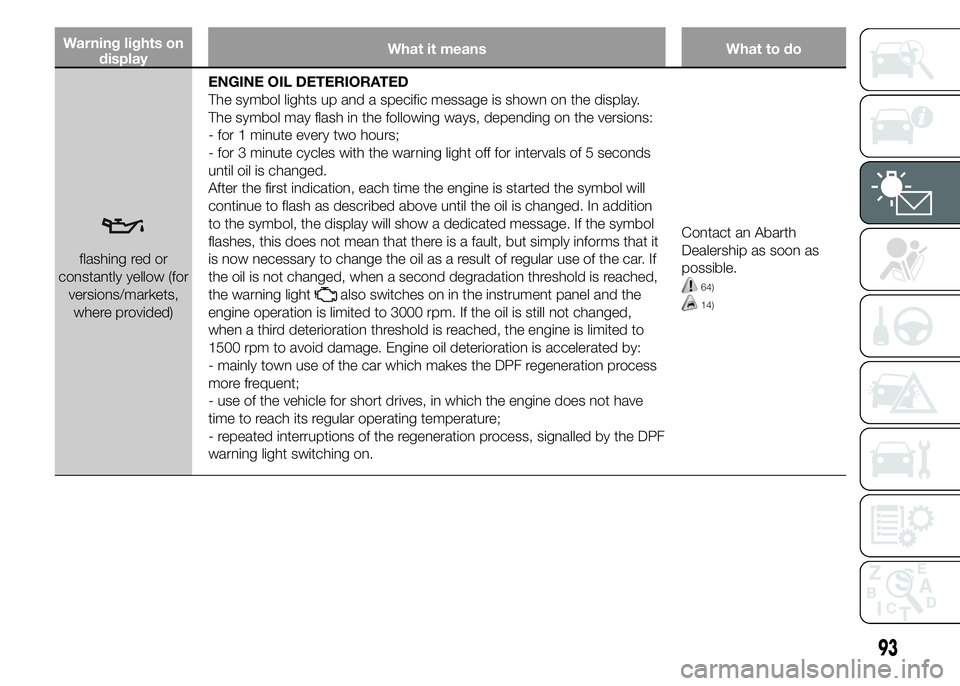
Warning lights on
displayWhat it means What to do
flashing red or
constantly yellow (for
versions/markets,
where provided)ENGINE OIL DETERIORATED
The symbol lights up and a specific message is shown on the display.
The symbol may flash in the following ways, depending on the versions:
- for 1 minute every two hours;
- for 3 minute cycles with the warning light off for intervals of 5 seconds
until oil is changed.
After the first indication, each time the engine is started the symbol will
continue to flash as described above until the oil is changed. In addition
to the symbol, the display will show a dedicated message. If the symbol
flashes, this does not mean that there is a fault, but simply informs that it
is now necessary to change the oil as a result of regular use of the car. If
the oil is not changed, when a second degradation threshold is reached,
the warning light
also switches on in the instrument panel and the
engine operation is limited to 3000 rpm. If the oil is still not changed,
when a third deterioration threshold is reached, the engine is limited to
1500 rpm to avoid damage. Engine oil deterioration is accelerated by:
- mainly town use of the car which makes the DPF regeneration process
more frequent;
- use of the vehicle for short drives, in which the engine does not have
time to reach its regular operating temperature;
- repeated interruptions of the regeneration process, signalled by the DPF
warning light switching on.Contact an Abarth
Dealership as soon as
possible.64)
14)
93
Page 98 of 215
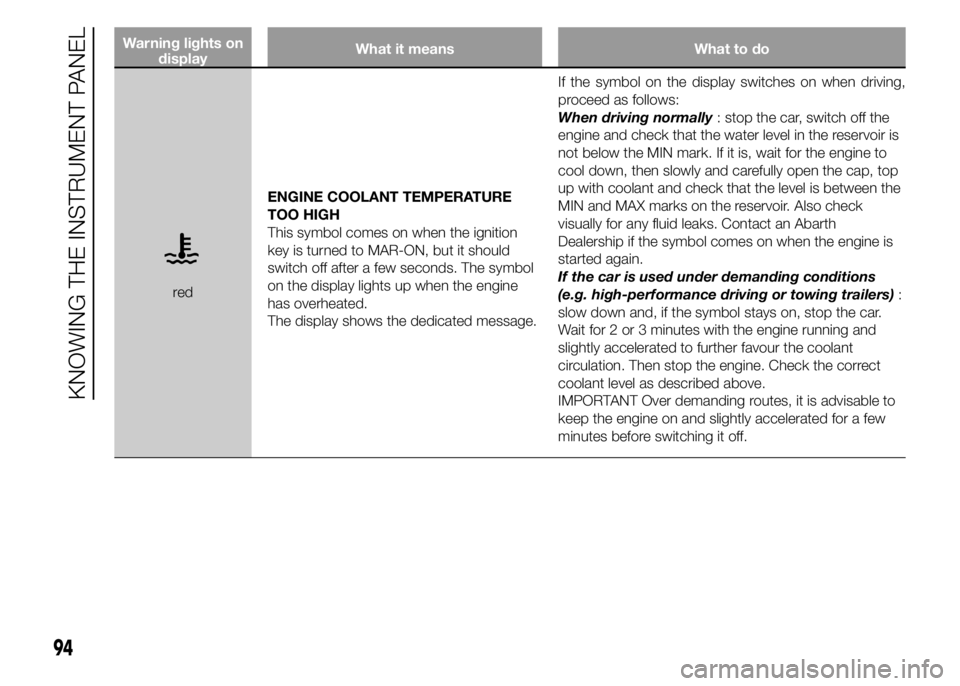
Warning lights on
displayWhat it means What to do
redENGINE COOLANT TEMPERATURE
TOO HIGH
This symbol comes on when the ignition
key is turned to MAR-ON, but it should
switch off after a few seconds. The symbol
on the display lights up when the engine
has overheated.
The display shows the dedicated message.If the symbol on the display switches on when driving,
proceed as follows:
When driving normally: stop the car, switch off the
engine and check that the water level in the reservoir is
not below the MIN mark. If it is, wait for the engine to
cool down, then slowly and carefully open the cap, top
up with coolant and check that the level is between the
MIN and MAX marks on the reservoir. Also check
visually for any fluid leaks. Contact an Abarth
Dealership if the symbol comes on when the engine is
started again.
If the car is used under demanding conditions
(e.g. high-performance driving or towing trailers):
slow down and, if the symbol stays on, stop the car.
Wait for 2 or 3 minutes with the engine running and
slightly accelerated to further favour the coolant
circulation. Then stop the engine. Check the correct
coolant level as described above.
IMPORTANT Over demanding routes, it is advisable to
keep the engine on and slightly accelerated for a few
minutes before switching it off.
94
KNOWING THE INSTRUMENT PANEL
Page 99 of 215
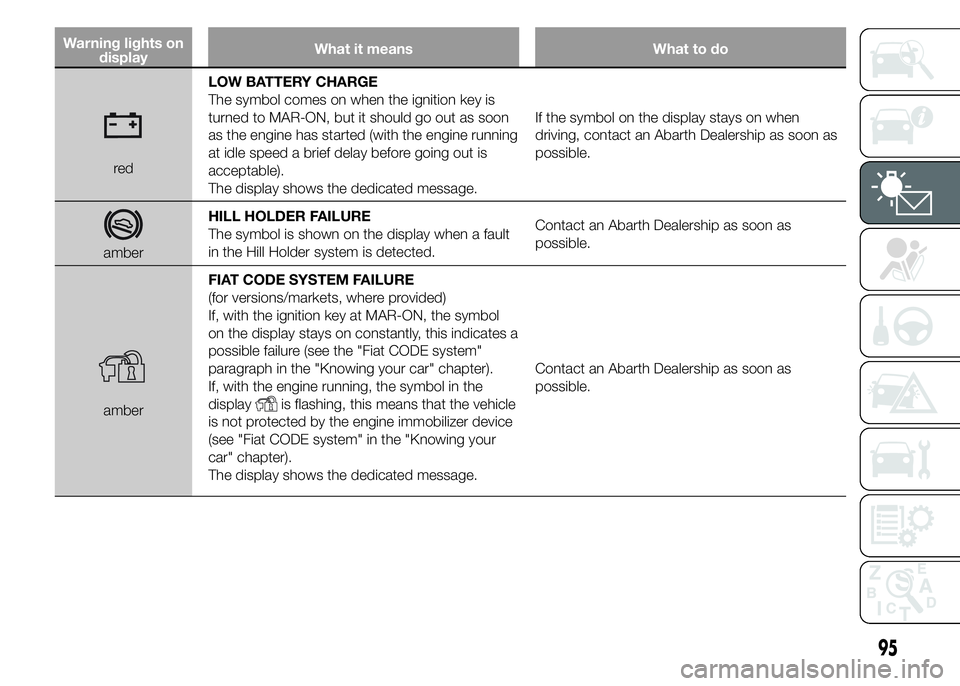
Warning lights on
displayWhat it means What to do
redLOW BATTERY CHARGE
The symbol comes on when the ignition key is
turned to MAR-ON, but it should go out as soon
as the engine has started (with the engine running
at idle speed a brief delay before going out is
acceptable).
The display shows the dedicated message.If the symbol on the display stays on when
driving, contact an Abarth Dealership as soon as
possible.
amberHILL HOLDER FAILURE
The symbol is shown on the display when a fault
in the Hill Holder system is detected.Contact an Abarth Dealership as soon as
possible.
amberFIAT CODE SYSTEM FAILURE
(for versions/markets, where provided)
If, with the ignition key at MAR-ON, the symbol
on the display stays on constantly, this indicates a
possible failure (see the "Fiat CODE system"
paragraph in the "Knowing your car" chapter).
If, with the engine running, the symbol in the
displayis flashing, this means that the vehicle
is not protected by the engine immobilizer device
(see "Fiat CODE system" in the "Knowing your
car" chapter).
The display shows the dedicated message.Contact an Abarth Dealership as soon as
possible.
95
Page 104 of 215
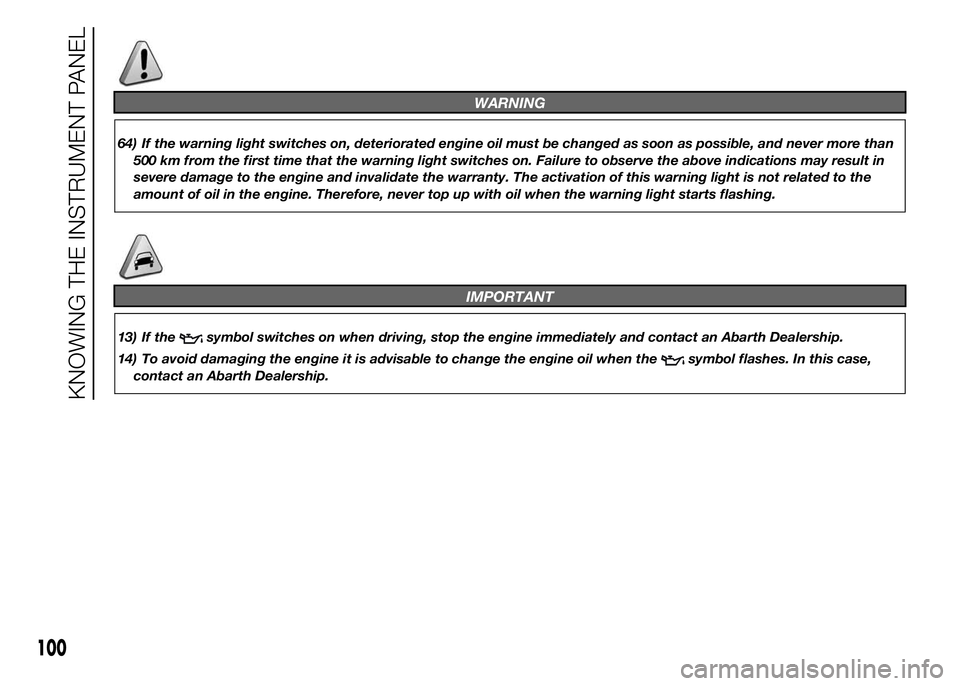
WARNING
64) If the warning light switches on, deteriorated engine oil must be changed as soon as possible, and never more than
500 km from the first time that the warning light switches on. Failure to observe the above indications may result in
severe damage to the engine and invalidate the warranty. The activation of this warning light is not related to the
amount of oil in the engine. Therefore, never top up with oil when the warning light starts flashing.
IMPORTANT
13) If thesymbol switches on when driving, stop the engine immediately and contact an Abarth Dealership.
14) To avoid damaging the engine it is advisable to change the engine oil when the
symbol flashes. In this case,
contact an Abarth Dealership.
100
KNOWING THE INSTRUMENT PANEL
Page 124 of 215

88) Always drive keeping your hands
on the steering wheel rim so that
the airbag can inflate freely if
necessary. Do not drive with your
body bent forward. Keep your
back straight against the
backrest.
89) If the car has been subject to
theft, attempted theft, vandalism,
or flooding, have the airbag
system inspected at an Abarth
Dealership.90) Airbags may be deployed if
another vehicle crashes into the
car, if the key is inserted and
at MAR-ON even if the engine is
not running and the car is
stationary. Therefore, even if the
car is stationary, when an active
front passenger airbag is fitted,
DO NOT install rear facing child
restraint systems on the front
passenger seat. Deployment of
the airbag following an impact
could cause fatal injuries to the
child. Therefore, always
deactivate the passenger airbag
when a rear facing child restraint
system is installed on the front
passenger seat. The front
passenger seat must also be
positioned back as far as possible
in order to prevent the child
restraint system from coming into
contact with the dashboard.
Immediately reactivate the
passenger airbag as soon as the
child restraint system has been
removed. Also remember that,
if the key is turned to STOP, none
of the safety devices (airbags or
pretensioners) will be deployed in
the event of collision. Non-
deployment in such cases does
not indicate a system malfunction.91) When the ignition key is turned
to MAR-ON, the
warning light
turns on and flashes for a few
seconds to remind you that the
passenger's airbag will be
deployed in a crash, after which it
should switch off.
92) Do not wash the seats with
water or pressurised steam (wash
by hand or at automatic car seat
washing stations).
93) The front airbag deployment
threshold is higher than that of
the pretensioners. For collisions in
the range between the two
thresholds, it is normal for only
the pretensioners to be activated.
94) Do not affix rigid objects to the
coat hooks or support handles.
95) The airbag does not replace seat
belts but increases their
effectiveness. Furthermore, since
front airbags are not deployed
in low-speed frontal impacts, side
impacts, rear shunts or roll-overs,
the passengers are protected
only by the seat belts which must
therefore be fastened at all times.
120
SAFETY
Page 125 of 215

STARTING AND DRIVING
Let’s get to the "heart" of the vehicle:
seeing how you can exploit all of its
potential to the full.
We’ll look at how to drive it safely in any
situation, so that it can be a welcome
companion, with our comfort and
our wallets in mind.STARTING THE ENGINE ................122
PARKING ........................................123
USING THE GEARBOX ...................124
SAVING FUEL .................................125
TOWING TRAILERS ........................126
SNOW TYRES ................................127
SNOW CHAINS ..............................127
CAR INACTIVITY .............................128
121
Page 126 of 215
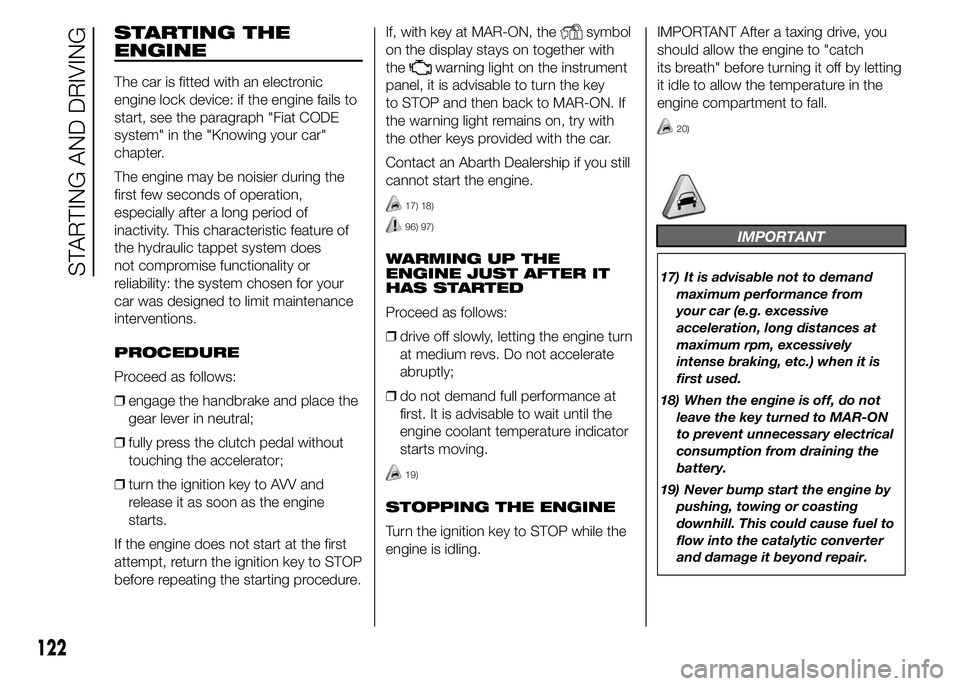
STARTING THE
ENGINE
The car is fitted with an electronic
engine lock device: if the engine fails to
start, see the paragraph "Fiat CODE
system" in the "Knowing your car"
chapter.
The engine may be noisier during the
first few seconds of operation,
especially after a long period of
inactivity. This characteristic feature of
the hydraulic tappet system does
not compromise functionality or
reliability: the system chosen for your
car was designed to limit maintenance
interventions.
PROCEDURE
Proceed as follows:
❒engage the handbrake and place the
gear lever in neutral;
❒fully press the clutch pedal without
touching the accelerator;
❒turn the ignition key to AVV and
release it as soon as the engine
starts.
If the engine does not start at the first
attempt, return the ignition key to STOP
before repeating the starting procedure.If, with key at MAR-ON, the
symbol
on the display stays on together with
the
warning light on the instrument
panel, it is advisable to turn the key
to STOP and then back to MAR-ON. If
the warning light remains on, try with
the other keys provided with the car.
Contact an Abarth Dealership if you still
cannot start the engine.
17) 18)
96) 97)
WARMING UP THE
ENGINE JUST AFTER IT
HAS STARTED
Proceed as follows:
❒drive off slowly, letting the engine turn
at medium revs. Do not accelerate
abruptly;
❒do not demand full performance at
first. It is advisable to wait until the
engine coolant temperature indicator
starts moving.
19)
STOPPING THE ENGINE
Turn the ignition key to STOP while the
engine is idling.IMPORTANT After a taxing drive, you
should allow the engine to "catch
its breath" before turning it off by letting
it idle to allow the temperature in the
engine compartment to fall.
20)
IMPORTANT
17) It is advisable not to demand
maximum performance from
your car (e.g. excessive
acceleration, long distances at
maximum rpm, excessively
intense braking, etc.) when it is
first used.
18) When the engine is off, do not
leave the key turned to MAR-ON
to prevent unnecessary electrical
consumption from draining the
battery.
19) Never bump start the engine by
pushing, towing or coasting
downhill. This could cause fuel to
flow into the catalytic converter
and damage it beyond repair.
122
STARTING AND DRIVING
Page 127 of 215
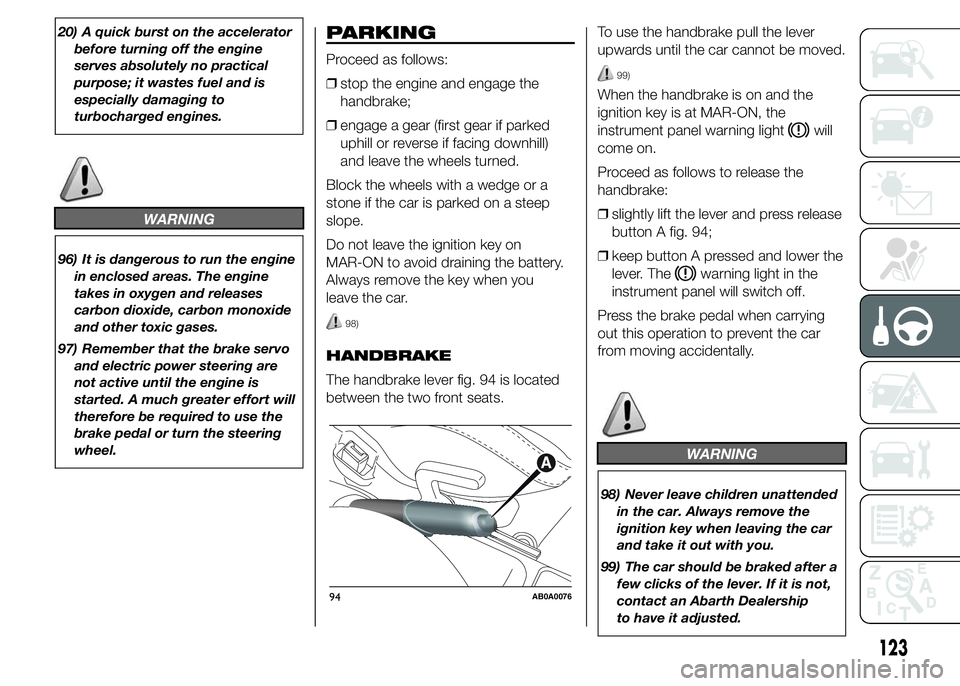
20) A quick burst on the accelerator
before turning off the engine
serves absolutely no practical
purpose; it wastes fuel and is
especially damaging to
turbocharged engines.
WARNING
96) It is dangerous to run the engine
in enclosed areas. The engine
takes in oxygen and releases
carbon dioxide, carbon monoxide
and other toxic gases.
97) Remember that the brake servo
and electric power steering are
not active until the engine is
started. A much greater effort will
therefore be required to use the
brake pedal or turn the steering
wheel.
PARKING
Proceed as follows:
❒stop the engine and engage the
handbrake;
❒engage a gear (first gear if parked
uphill or reverse if facing downhill)
and leave the wheels turned.
Block the wheels with a wedge or a
stone if the car is parked on a steep
slope.
Do not leave the ignition key on
MAR-ON to avoid draining the battery.
Always remove the key when you
leave the car.
98)
HANDBRAKE
The handbrake lever fig. 94 is located
between the two front seats.To use the handbrake pull the lever
upwards until the car cannot be moved.
99)
When the handbrake is on and the
ignition key is at MAR-ON, the
instrument panel warning light
will
come on.
Proceed as follows to release the
handbrake:
❒slightly lift the lever and press release
button A fig. 94;
❒keep button A pressed and lower the
lever. The
warning light in the
instrument panel will switch off.
Press the brake pedal when carrying
out this operation to prevent the car
from moving accidentally.
WARNING
98) Never leave children unattended
in the car. Always remove the
ignition key when leaving the car
and take it out with you.
99) The car should be braked after a
few clicks of the lever. If it is not,
contact an Abarth Dealership
to have it adjusted.
94AB0A0076
123
Page 128 of 215
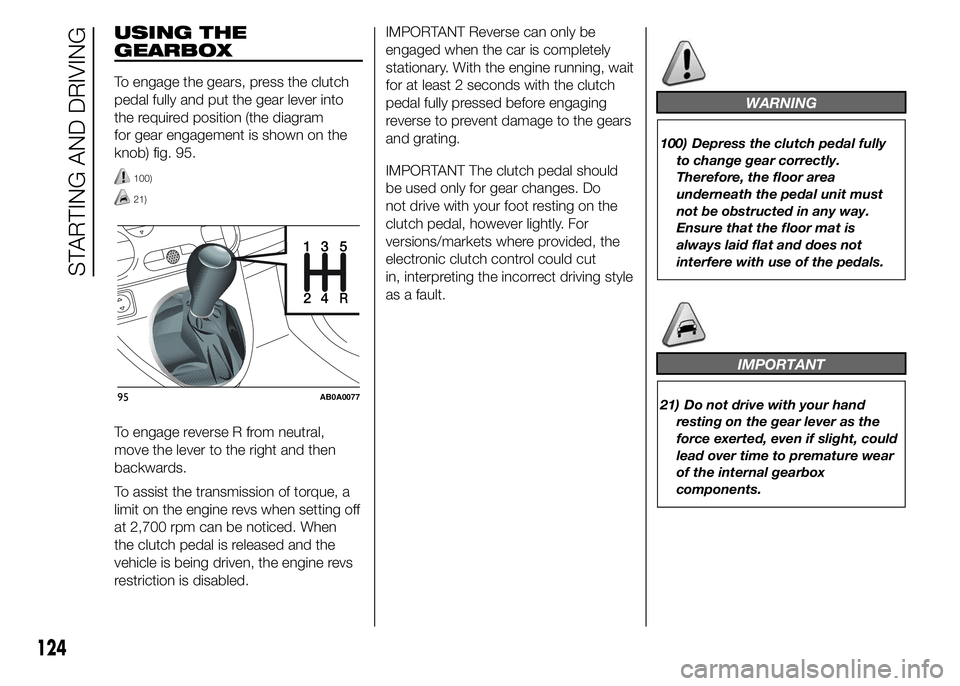
USING THE
GEARBOX
To engage the gears, press the clutch
pedal fully and put the gear lever into
the required position (the diagram
for gear engagement is shown on the
knob) fig. 95.
100)
21)
To engage reverse R from neutral,
move the lever to the right and then
backwards.
To assist the transmission of torque, a
limit on the engine revs when setting off
at 2,700 rpm can be noticed. When
the clutch pedal is released and the
vehicle is being driven, the engine revs
restriction is disabled.IMPORTANT Reverse can only be
engaged when the car is completely
stationary. With the engine running, wait
for at least 2 seconds with the clutch
pedal fully pressed before engaging
reverse to prevent damage to the gears
and grating.
IMPORTANT The clutch pedal should
be used only for gear changes. Do
not drive with your foot resting on the
clutch pedal, however lightly. For
versions/markets where provided, the
electronic clutch control could cut
in, interpreting the incorrect driving style
as a fault.
WARNING
100) Depress the clutch pedal fully
to change gear correctly.
Therefore, the floor area
underneath the pedal unit must
not be obstructed in any way.
Ensure that the floor mat is
always laid flat and does not
interfere with use of the pedals.
IMPORTANT
21) Do not drive with your hand
resting on the gear lever as the
force exerted, even if slight, could
lead over time to premature wear
of the internal gearbox
components.
24R351
95AB0A0077
124
STARTING AND DRIVING
Page 129 of 215
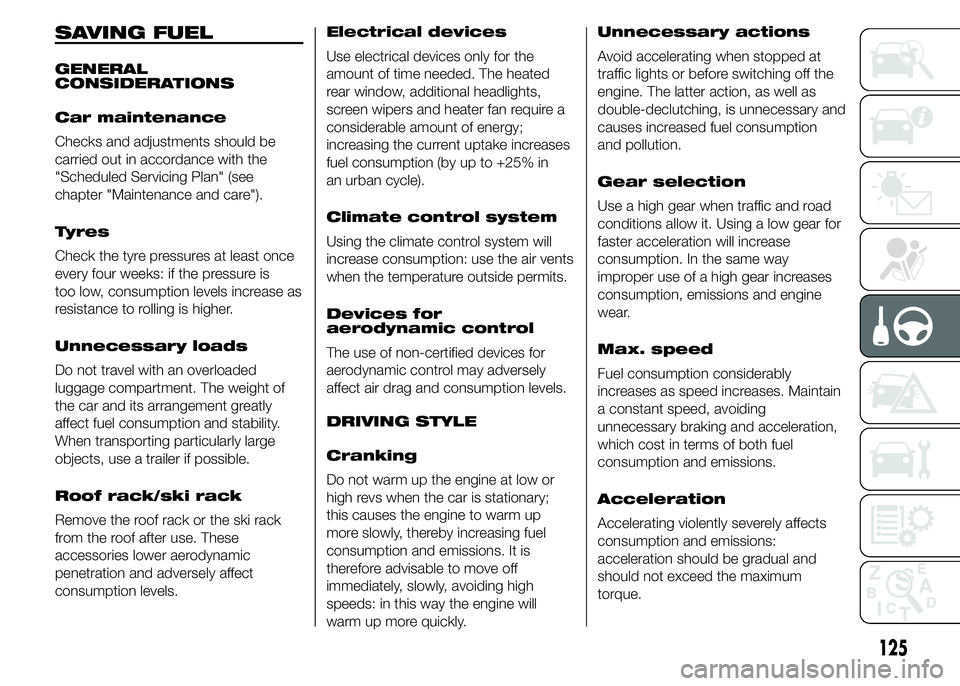
SAVING FUEL
GENERAL
CONSIDERATIONS
Car maintenance
Checks and adjustments should be
carried out in accordance with the
"Scheduled Servicing Plan" (see
chapter "Maintenance and care").
Tyres
Check the tyre pressures at least once
every four weeks: if the pressure is
too low, consumption levels increase as
resistance to rolling is higher.
Unnecessary loads
Do not travel with an overloaded
luggage compartment. The weight of
the car and its arrangement greatly
affect fuel consumption and stability.
When transporting particularly large
objects, use a trailer if possible.
Roof rack/ski rack
Remove the roof rack or the ski rack
from the roof after use. These
accessories lower aerodynamic
penetration and adversely affect
consumption levels.Electrical devices
Use electrical devices only for the
amount of time needed. The heated
rear window, additional headlights,
screen wipers and heater fan require a
considerable amount of energy;
increasing the current uptake increases
fuel consumption (by up to +25% in
an urban cycle).
Climate control system
Using the climate control system will
increase consumption: use the air vents
when the temperature outside permits.
Devices for
aerodynamic control
The use of non-certified devices for
aerodynamic control may adversely
affect air drag and consumption levels.
DRIVING STYLE
Cranking
Do not warm up the engine at low or
high revs when the car is stationary;
this causes the engine to warm up
more slowly, thereby increasing fuel
consumption and emissions. It is
therefore advisable to move off
immediately, slowly, avoiding high
speeds: in this way the engine will
warm up more quickly.Unnecessary actions
Avoid accelerating when stopped at
traffic lights or before switching off the
engine. The latter action, as well as
double-declutching, is unnecessary and
causes increased fuel consumption
and pollution.
Gear selection
Use a high gear when traffic and road
conditions allow it. Using a low gear for
faster acceleration will increase
consumption. In the same way
improper use of a high gear increases
consumption, emissions and engine
wear.
Max. speed
Fuel consumption considerably
increases as speed increases. Maintain
a constant speed, avoiding
unnecessary braking and acceleration,
which cost in terms of both fuel
consumption and emissions.
Acceleration
Accelerating violently severely affects
consumption and emissions:
acceleration should be gradual and
should not exceed the maximum
torque.
125